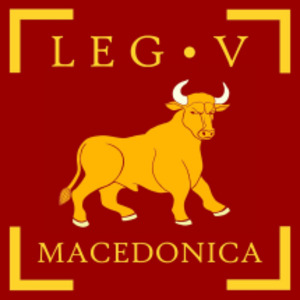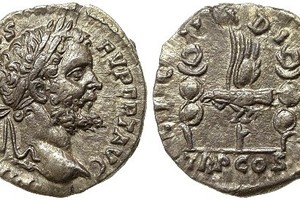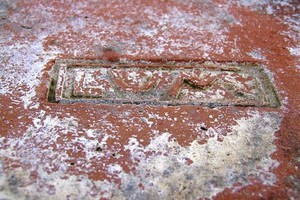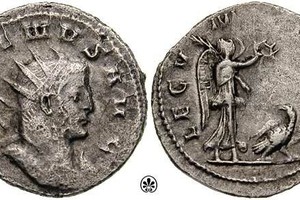Roman Legion - Legio V Macedonica
Legio V Macedonica (Fifth Macedonian Legion) was a Roman legion formed by Octavian Augustus.
Dates of existence: Formed in 43 BC. The legion existed until 476 AD and later became part of the Eastern Roman Empire's army.
Symbols: Bull and Eagle.
Nicknames: Macedonica (Macedonian), Pia Constans (Loyal and Reliable) or Pia Fidelis (Pious and Faithful), Pia III Fidelis III (Thrice Pious and Faithful).
Battle Path
- Legio V Macedonica was formed in 43 BC by order of Octavian Augustus. Nothing is known about the legion's actions in its first decade.
- The legion participated as boarding crews in the naval battle between Octavian and Mark Antony forces at the Battle of Actium in 31 BC.
- From 30 BC to 6 AD, Legio V Macedonica was stationed in Macedonia, from which it received its cognomen "Macedonian."
- From 6 to 61 AD, Legio V Macedonica was transferred to Moesia (the region between the Lower Danube and the Balkan Mountains, now part of Bulgaria, Serbia, Romania, and Ukraine) to a place called Eskus (modern-day Gigen, Bulgaria) to guard the empire's border along the Lower Danube from Dacian attacks. This is evidenced by roof tiles found with its stamps.
- In 62 AD, the legion was moved east to Pontus (a northeastern region of Asia Minor) to fight the Parthians. The legion was then commanded by Annius Vinicianus, the son-in-law of the governor of Syria, Gnaeus Domitius Corbulo.
- During the First Jewish War (Revolt), Legio V Macedonica also participated. At that time, it was commanded by the future emperor Vespasian. Vespasian commanded the legion in 66-67 AD. During this time, the legionaries of the Fifth Legion distinguished themselves in Galilee during the liberation of the city of Sepphoris (the historical capital of Galilee, located 6 km northwest of Nazareth) in 67 AD, and the legionaries of Legio V Macedonica distinguished themselves in the assault on the main Samaritan sanctuary, Mount Gerizim (now a mountain in the center of Samaria, the southern outskirts of the city of Nablus, Israel).
- In 68-69 AD, the legion was stationed in a camp near Emmaus (a settlement 30 km from Jerusalem, now the ruins of the settlement at the site of Latrun, the crossroads of the road from Jerusalem to Tel Aviv) in Judea because its former legate, declared emperor, was fighting for the imperial throne, which became vacant after Nero's death in 68 AD during the year of the four emperors.
- The new emperor Vespasian's son, Titus, deployed the legion for the siege and assault of Jerusalem in 70 AD. After that, Legio V Macedonica accompanied Titus to Alexandria and in 71 AD was returned to its old base in Moesia, in the city of Eskus (Oescus).
- In mid-86 AD, Emperor Domitian reformed the provinces, because the Dacians attacked the province of Moesia and defeated the local troops. As part of Domitian's reforms, Legio V Macedonica was now stationed in Lower Moesia (the province of Moesia was divided into Upper and Lower).
- n 88 AD, Legio V Macedonica participated in a campaign against the Dacians and fought at the Battle of Tapae. However, in 89 AD, the campaign ended due to internal problems within the Empire.
- During the reign of Emperor Trajan 's Legio V Macedonica was used in his military campaigns against the Dacians in 101-106 AD. At this time, one of the legion's officers was the future Roman Emperor Hadrian.
- After the Dacian campaign, the legion was transferred in 107 AD to the northeastern part of Moesia in Troesmis (modern-day Iglița, Romania) near the Danube delta to protect Rome's borders from the Roxolani tribe's attacks. Legio V Macedonica also participated in Emperor Trajan's Parthian campaign in 115-117 AD. After that, it was returned to Moesia. Here, together with other legions stationed in Moesia, it periodically sent detachments (vexillationes) to guard and defend Crimea.
- During Emperor Hadrian's reign, the legion was involved in suppressing the Bar Kokhba revolt (132-136 AD). For this, it was again transferred to the East, to Judea. After suppressing the revolt, the legion was returned to Moesia.
- n the 2nd century AD, during Lucius Verus's reign, Legio V Macedonica was again sent east to participate in the Parthian War of 161-166 AD. After that, the legion was returned to Dacia, but it was stationed in Potaissa (modern-day Turda, Romania). Today, there is a museum in Turda at the site of Legio V Macedonica's military camp, where one can learn about the living conditions, daily life, and service of this legion's legionaries.
- In 185 or 187 AD, Legio V Macedonica participated in battles with a mercenary army hired by the rebellious workers of the Dacian gold mines. After defeating this army, the legion received the nickname Pia Constans (Loyal and Reliable) or Pia Fidelis (Pious and Faithful) from Emperor Commodus.
- In the Year of the Five Emperors (193 AD), Legio V Macedonica supported the candidacy of the future emperor Lucius Septimius Severus.
- For most of the 3rd century, the legion was stationed at its camp in Potaissa. During this time, the legion fought the Carpi tribe from the Carpathians and, together with Legio XIII Gemina Pia Fidelis defeated them in 244-245 AD.
- In the 250s AD, Emperor Valerian awarded the legion the title Pia III Fidelis III (Thrice Pious and Faithful), although it is unknown why the legion was honored a second time with the title of pious and faithful.
- During the reign of Valerian's son, Emperor Gallienus (ruled 260-268 AD), Legio V Macedonica received the titles Pia VII Fidelis VII, probably for supporting the emperor in his struggle against the usurpers Ingenuus and Regalianus (260 AD) in Moesia. At that time, the legion used a novelty for those years—mobile cavalry.
- In 274 AD, Emperor Aurelian (ruled 270-275 AD) abandoned Dacia, and the legion was transferred for the third time to the city of Eskus (Oescus) in Moesia. The cavalry unit established by Gallienus was separated from the legion by Emperor Diocletian (ruled 284-305 AD) and in 293 AD was sent to Egypt, where it remained until the early 5th century.
- In Moesia, the legion's infantry units remained until the end of the Western Roman Empire in 476 AD.
- The last mention of the legion dates to 635 AD when it was part of the Eastern Roman Empire's army and participated in strengthening the walls of Heliopolis (modern-day Baalbek, Lebanon).
Related topics
Legion, Legionnaire, Octavian Augustus, Mark Antony, Year of the Four Emperors, Year of the Five Emperors, Marcus Ulpius Nerva Trajan, Diocletian, Legio XIII Gemina Pia Fidelis
Literature
- Dando Collins " The Complete History of the Roman Legions”
- Legion on livius.org
- R. Kanya "Legion" A brief description of the history of the legions
- Roman Glory. Ancient military art






